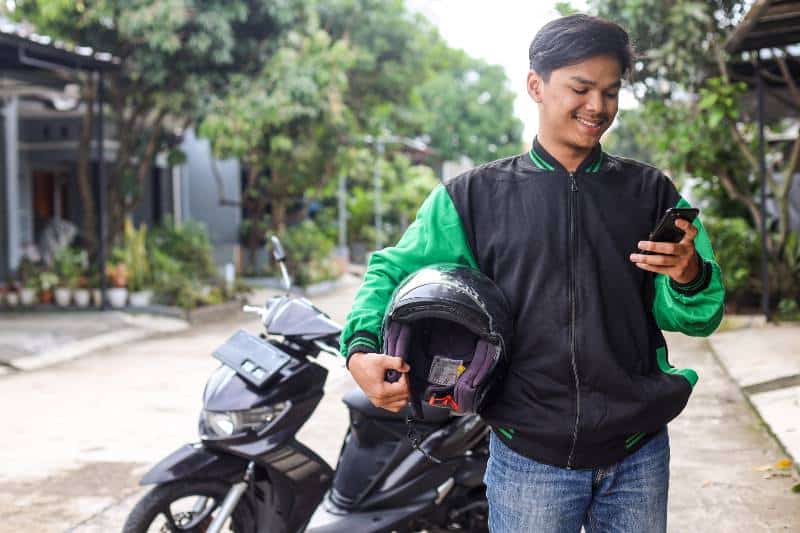Gear Up: Essential Safety Tips for Thai Motorcycle Rides
Exploring the world on two wheels is an incredible experience, and what better place to explore than Thailand? With it’s stunning coastline, delicious cuisine, and vibrant culture, Thailand offers some of the most breathtaking riding in Asia. Unfortunately, with the lack of safety regulations comes a greater risk for injury or death while traversing the roads. To ensure that you experience all of beautiful Thailand has to offer without risking your safety and wellbeing, we have gathered tips from locals to help minimize any risks associated with motorcycle travel within this amazing country. Read on!
In Thailand, motorcycling is high-risk due to chaotic roads and frequent disregard for rules. Ensure a valid license, wear a robust helmet, avoid night rides, and approach zebra crossings with caution. Always prioritize safety and reconsider motorbike use in high-traffic areas.
Key Takeaways
- Understanding and respecting Thailand’s unique traffic conditions and local customs is crucial for a safe motorcycle journey.
- Wearing the right protective gear, especially helmets, can make a significant difference in ensuring rider safety.
- Familiarizing oneself with local road signs, signals, and emergency procedures can prevent accidents and ensure a smooth ride.

Understanding Thailand’s Traffic Conditions
Thailand, known for its beautiful beaches, rich cultural heritage, and bustling city life, is a nation where the unexpected can often be the rule, particularly when it comes to traffic conditions. With an enthralling amalgamation of cars, motorbikes, three-wheeled tuk-tuks, and an array of other vehicles, Thai roads present a unique challenge for both the casual traveler and the seasoned commuter.
Common Traffic Scenarios in Urban and Rural Areas
The traffic scenarios in Thailand vary widely, from the hubbub of its urban metropolises to the tranquility of its rural back roads. In the urban areas, such as Bangkok and Chiang Mai, traffic is often congested, with bumper-to-bumper lines of vehicles moving at a snail’s pace during peak hours. These areas are a meander of cars, taxis, buses, motorcycles, and pedestrians, all vying for space in a chaotic dance that somehow manages to flow.
In contrast, the rural regions present their own set of challenges where the roads may be less crowded, but drivers need to be cautious of unexpected elements, such as wandering livestock, uneven road surfaces, unpredictable bends, and occasional flooding during the rainy season. The cultural practice of respecting seniority often translates into local driving etiquette, where larger vehicles may assert their right of way over smaller ones, adding a complex layer of social dynamics onto an already challenging driving experience.
Unique Road Challenges in Thailand
The unique road challenges in Thailand stem from a mix of cultural mores, infrastructure conditions, and the country’s geographical diversity. Lack of proper signage in many areas coupled with a significant language barrier can make navigation a daunting task for non-Thai speakers.
Thailand’s roads are also known for their sheer busyness and the unpredictability of other road users, from overtaking tuk-tuks to zig-zagging motorcycles, presenting a continuous test of nerve and skill for drivers. Furthermore, weather conditions can drastically alter road situations, with sudden torrential rainstorms making for slippery, hazardous conditions, and dense fog in the mountainous regions reducing visibility to dangerous levels.
Understanding and navigating Thailand’s traffic conditions requires a mix of patience, alertness, adaptability, and respect for local customs. Despite these challenges, millions of tourists and locals manage to navigate these roads each year, their journey made easier by keeping an open mind, maintaining awareness of their surroundings, and respecting the unwritten rules of the road laid down by local traditions and practices.
Essential Safety Gear
When it comes to riding motorcycles or bicycles, safety should always be paramount. Ensuring protection while on the road begins with equipping yourself with the correct safety gear. This gear ranges from helmets to protective clothing, footwear, and reflective items for nighttime visibility. Let’s take a closer look at these elements.
Importance of Helmets and their Legal Requirements
Helmets are undoubtedly the most essential piece of safety gear. They protect the wearer’s head, one of the most vulnerable parts of the body during a crash. Research has consistently shown that helmet use can significantly reduce the risk of serious injury and fatality in accidents.
In many parts of the world, including Thailand, it is legally required for experienced rider as well as inexperienced and their passengers to wear a helmet. Failure to adhere to these regulations can result in stiff penalties, and more importantly, jeopardizes the safety of road users.
Helmets should meet certain safety standards, fit properly, and generally be replaced every five years or immediately after a crash. Full-face helmets provide the best protection as they cover the entire head and face.
Protective Clothing and Footwear
Many motorcycle riders may overlook the importance of protective clothing and footwear, but these items play an essential role in keeping you safe on the road.
Protective clothing includes items like jackets, pants, and gloves. Such gear is typically made from heavy-duty materials like leather or specialized synthetics, which are designed to resist abrasion and provide some level of impact protection. Riders should look for clothing that covers the full length of their arms and legs.
Footwear, specifically riding boots, offer protection for feet and ankles. They should be sturdy, with non-slip soles and ankle supports, protecting you from severe injuries while also providing an improved grip on road surfaces.
Reflective Gear for Nighttime Riding
Visibility on the road is key to road safety, particularly when riding at night. Reflective gear helps by making riders more noticeable to other road users, which is vital in preventing accidents.
Reflective gear can come in various forms, such as high-visibility vests, strips or decals on helmets, and reflective patches on clothing. Many pieces of motorcycle clothing will already include reflective sections. Additionally, riders can attach reflective tape to their bikes to increase visibility.
Investing in and correctly using high-quality safety gear significantly enhances the rider’s safety on the roads. It reduces the risk of severe injury in the case of an accident and even helps prevent accidents from happening in the first place. It’s a small price to pay for a safer and more secure riding experience.
Safe Riding Techniques
Safety while riding a motorcycle or bicycle involves much more than just donning appropriate gear; it also hinges on mastering safe riding techniques. Here are a few critical aspects to consider:
Defensive Riding in Heavy Traffic
Defensive riding is a proactive approach taken by riders to protect themselves from potential problems on the road. It includes maintaining a safe following distance, staying out of blind spots, and avoiding sudden brakes or changes in opposite direction. In heavy traffic, always anticipate other drivers’ actions, keep distance, and be prepared for unexpected maneuvers.
Handling the Monsoon Rains and Slippery Roads
Riding in wet conditions, especially during the monsoon season, demands special skills and precautions. Ensure your tires are in good condition to maximize grip on slippery roads. Moreover, reducing your speed, braking gently, and avoiding puddles can minimize the risk of skidding or hydroplaning.
Navigating through Busy Markets and Narrow Lanes
Busy markets and narrow lanes can be daunting for any rider. The key is to remain patient, keep a slow speed and be constantly aware of pedestrians, street vendors, and other vehicles. Close encounters can be frequent in these settings, so it’s vital to hone your low-speed maneuvering skills and always be prepared to stop.
Legal Requirements and Local Customs
Licensing and Insurance Requirements:
Do not ride a motorbike in Thailand if you do not have a driving license to do so in your own country.
- Never hand over your passport to rental companies. Some may use it as leverage to scam foreigners by claiming damages. Instead, offer a photocopy of your passport. If they insist on the original, consider another rental company.
Understanding Local Road Signs and Signals:
Thailand has a high rate of motorcycle deaths, making it one of the most dangerous countries for motorcyclists.
- Motorists often disobey road rules, and the roads can be chaotic. car drivers and trucks can be unpredictable, and motorcyclists often weave between lanes without helmets.
- Avoid riding at night. Some motorcyclists ride in the wrong way or direction without headlights, and drunk driving is common after dark.
- Zebra crossings are often ignored, especially by motorcyclists. Be extra cautious when approaching these crossings.
Respecting Religious Processions and Ceremonies on the Road:
The article does not specifically mention religious processions and ceremonies on the road. However, given the general road behavior, it would be wise to approach any road gathering with caution and respect.
Additional Tips:
- Reconsider riding a motorbike in Thailand due to the high risks.
- Ensure you wear a safe helmet. Many helmets and rent bikes are for rent in Thailand are not robust. Consider purchasing a high-quality helmet if necessary.
- Be wary of scams when renting motorbikes. Some rental agencies might claim damages and demand payment.
Emergency Situations
Riding on Thailand’s diverse and often unpredictable roads includes the risk of emergencies such as accidents or injuries. Preparedness and awareness are critical aspects of addressing these emergency situations aptly. Here’s a guide for handling these challenging circumstances.
What to Do in Case of an Accident
If you’re involved in a bike accident, the first thing to do is maintain calm and assess the situation. If feasible, move yourself and your vehicle out of traffic to a safe location. Check if anyone involved requires medical attention and call emergency services if needed.
Once you’ve dealt with any immediate threats to life and safety, try to gather as much information as possible. This information could include the names and contact information of other people involved and any witnesses, details of the accident, and photographs of the scene and the damage.
It’s also essential to report the accident to local law enforcement authorities and your insurance company, providing them with an accurate account of the events.
Local Emergency Numbers and Services in Thailand
In case of emergencies in Thailand, it’s crucial to be aware of the local emergency numbers:
- Police: 191
- Ambulance and Rescue: 1554
- Tourist Police: 1155
The “Tourist Police” in Thailand is particularly helpful for tourists who have been in motorcycle accidents and need assistance dealing with local laws and language barriers.
Importance of First Aid Knowledge
Knowing basic first aid procedures can be invaluable in the aftermath of an accident. The few moments after an accident are usually the most crucial and can make the difference between life and death.
First aid knowledge can help treat minor injuries or stabilize a victim until professional help arrives. Knowing how to respond to bleeding, fractures, or shock can potentially save a life.
In light of this, attending a basic first aid course is recommended for everyone, especially those who frequently navigate the roads on motorcycles or bicycles.
In summary, confronting an emergency situation effectively requires a calm mindset, readiness to give or seek help, knowledge of local emergency contacts, and a basic knowledge of first aid. Awareness and preparation ensure you’re well-equipped to handle any unexpected occurrence.
Motorcycle Safety in Thailand FAQs
Is it safe to ride a motorcycle in Thailand?
Riding a motorcycle in Thailand can be risky due to the high rate of accidents and reckless driving and road behavior. As such, it is essential to take precautions such as wearing a helmet, riding defensively, and avoiding driving at night.
What documents do I need to rent a motorcycle in Thailand?
To rent a motorcycle in Thailand, you will need an ID card or passport, a valid driver’s license, and an International Driving Permit (IDP). You may also need to make a deposit.
What is the legal speed limit in Thailand?
The speed limit varies depending on where you are driving. On highways, roads outside of urban centers, and expressways, the maximum speed is 120 km/h. In residential areas, the speed limit is 40 km/h.
Is it hard to drive a motorbike in Thailand?
Driving a motorbike in Thailand is not necessarily difficult, but it can be dangerous. It is important to familiarize yourself with the rules of the road and to always drive defensively. Additionally, honing your low-speed maneuvering skills and avoiding driving at night is essential for staying safe on the roads in Thailand.
Is it safe for foreigners to drive in Thailand?
Thailand’s roads can pose a significant risk if your mind tends to wander. It is crucial to always remain attentive, drive defensively, not take any road signs or rules for granted, and if possible, avoid driving at night, particularly during late hours to minimize encounters with intoxicated drivers.
Conclusion
Motorcycle safety in Thailand is essential and should not be taken lightly. As seen throughout this blog, there are some emergency situations that you can find yourself in on a motorcycle and you should be prepared for them as best as possible. This includes being knowledgeable with first aid, having local emergency contacts and numbers on hand, and knowing what to do in case of an accident.
We also recommend that all travelers have up-to-date insurance coverage when traveling abroad. Our goal has been to make sure everyone understands the importance of their safety while riding a motorcycle in Thailand.
Lastly, don’t forget to also subscribe to our weekly newsletter for the best resources about living in Thailand or reach out directly with any specific questions related to Thai culture, lifestyle or second language practices. Although travelling can be adventurous and exciting, nothing compares to feeling empowered and informed while aboard your favorite two-wheels!






